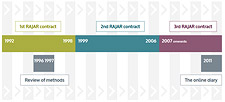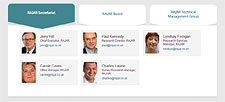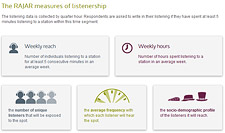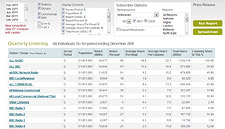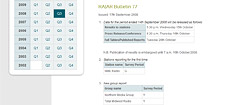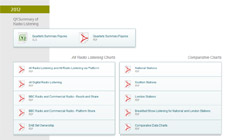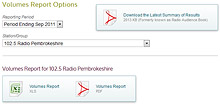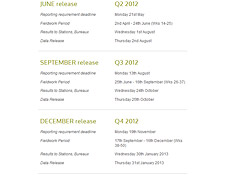The RAJAR research service
Contracts and Fees
The current RAJAR service operates on a calendar year basis. Radio stations commit to RAJAR for the duration of the contract and fees are revised annually, on the basis of an agreed indexation formula. Non-broadcaster subscriptions and bureau licences are renewable every twelve months.
Sample Size Requirements
Measurement of audiences for all radio services is continuous throughout 50 weeks of the year, but excluding the Christmas and New Year holiday period.
Results are published on a quarterly basis, but based on the appropriate minimum survey period, according to each station's survey area adult population and the minimum reporting sample required.
| ANALOGUE / DIGITAL SERVICES | |
|---|---|
| Population aged 15+ (000s) | Based on |
| > 12,000 | Quarter |
| 8,000 – 11,999 | Quarter |
| 6000 – 7,999 | Quarter |
| 4,000 – 5,999 | Quarter |
| 1,750 – 3,999 | 6 Months |
| 1,000 – 1,749 | 6 Months |
| 500 – 999 | 6 Months |
| 300 – 499 | 12 Months |
| < 300 | 12 Months |
| Opt outs | 12 Months |
| DIGITAL ONLY SERVICES | |
|---|---|
| Population aged 15 + (000s) | Based on | > 12,000 | Quarter |
| 8,000 – 11,999 | 6 Months |
| 6000 – 7,999 | 6 Months |
| 4,000 – 5,999 | 6 Months |
| 1,750 – 3,999 | 12 Months |
| 1,000 – 1,749 | 12 Months |
| 500 – 999 | 12 Months |
What the above tables show is that, for example, all Commercial stations with TSA (Total Survey Area) populations of between 4 and 6 million report on the basis of a minimum sample size of 1000 gathered over 3 months. For stations with populations between 1 million and 4 million, the reporting sample of 800 is built up over six months, etc…
These sample sizes and minimum survey periods are the basis for publication of individual station results, except for those stations with a reach of 4% or lower in their own TSA. These stations are allowed to choose a longer reporting period than the one dictated by this table - if their TSA size dictates they should report on a sample built over 3 months, they can choose to report on 6 months instead, and if they fall in the 6 month reporting period category, they can choose to report on 12 months instead.
Click here for a detailed fieldwork timetable.
Data Collection
Information is collected by means of a seven day self-completion diary. Diaries are personally placed with one selected adult (15+) and up to two children aged 10-14 years (according to the number of children present) in each selected household.
The paper diary is customised at placement. Each respondent is asked to sort through a set of cards with the names of all the radio stations in the area and invited to select all the stations which they might listen to or hear in various situations. This process provides a station repertoire for the selected individual which is then entered in the diary by the interviewer, using station name labels. All paper diaries are collected personally by interviewers at the end of the seven days.
The online diary station selection is carried out by the respondent, each person is asked to look through a set of station names onscreen that are available in the area and invited to select all the stations which they might listen to or hear in various situations.
Details of the fieldwork procedures are given in the Sampling & Fieldwork section.
See 'Development' section for introduction of modified methodology
The Rolling Sample
All participating stations report every quarter. However, only the largest stations, the national services, the majority of London stations and the other large regional services report on the basis of a completely new sample. For other stations, the listening figures are refreshed with the latest quarter's data whilst the figures for the earliest relevant quarter are dropped, as the sample 'rolls' forward to provide the 'latest six months' or 'latest 12 months' base for reporting.
A set of publication rules has been created in order to address the need for air-time negotiations to be conducted on combinations which include stations reporting on different minimum survey periods. Similarly, the rules also give guidance to the stations on the comparisons which can - and cannot be made in sales and promotional material.


